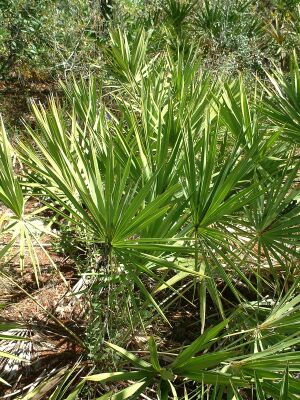- Serenoa
Taxobox
name = "Serenoa"
status = LC

image_width = 240px
image_caption = Saw Palmetto, Central Florida
regnum =Plant ae
divisio = Magnoliophyta
classis =Liliopsida
ordo =Arecales
familia =Arecaceae
subfamilia =Coryphoideae
tribus =Corypheae
genus = "Serenoa"
genus_authority = Hook.f.
species = "S. repens"
binomial = "Serenoa repens"
binomial_authority = (Bartram) J.K.Small"Serenoa repens", the saw palmetto, is the sole
species currently classified in thegenus "Serenoa". It has been known by a number of synonyms, including "Sabal serrulatum", under which name it still often appears inalternative medicine . It is a small palm, normally reaching a height of around 2-4 m. Its trunk is sprawling, and it grows in clumps or dense thickets in sandy coastal lands or as undergrowth inpine woods orhardwood hammocks. Erect stems or trunks are rarely produced but are found in some populations. It is endemic to the southeasternUnited States , most commonly along the Atlantic and Gulf coastal plains, but also as far inland as southernArkansas . It is extremely slow growing, and long lived, with some plants, especially inFlorida , possibly being as old as 500-700 years [cite paper | author =George W. Tanner, J. Jeffrey Mullahey and David Maehr | title =Saw-palmetto: An Ecologically and Economically Important Native Palm | version = Circular WEC-109 | publisher = University of Florida Cooperative Extension Service | date = July 1996 | url = http://edis.ifas.ufl.edu/pdffiles/UW/UW11000.pdf] .Saw palmetto is a fan palm (Arecaceae tribe Corypheae), with the leaves that have a bare petiole terminating in a rounded fan of about 20 leaflets. The petiole is armed with fine, sharp teeth or spines that give the species its common name. The leaves are light green inland, and silvery-white in coastal regions. The leaves are 1-2 m in length, the leaflets 50-100 cm long. They are similar to the leaves of the palmettos of genus "Sabal". The
flower s are yellowish-white, about 5 mm across, produced in dense compound panicles up to 60 cm long. Thefruit is a large reddish-blackdrupe and is an important food source for wildlife and historically for humans. The plant is used as a food plant by thelarva e of someLepidoptera species including "Batrachedra decoctor " (which feeds exclusively on the plant).The genus name honors American
botanist Sereno Watson .Saw palmetto extract
The fruits of the saw palmetto are highly enriched with
fatty acid s andphytosterol s, and extracts of the fruits have been the subject of intensive research for the treatment of urinary tract infections. This extract is also commonly used for other medical issues.The existing literature on "S. repens" for treatment of
benign prostatic hyperplasia (BPH) is limited in terms of the short duration of studies and variability in study design, use of phytotherapeutic preparations, and reports of outcomes.A systematic review in 1998 concluded that "the evidence suggests that "S. repens" improves urologic symptoms and flow measures. Compared with
finasteride , "S. repens" produces similar improvement in urinary tract symptoms and urinary flow and was associated with fewer adverse treatment events. Further research is needed using standardized preparations of "S. repens" to determine its long-term effectiveness and ability to prevent BPH complications."cite journal | author=Wilt TJ "et al" | title=Saw palmetto extracts for treatment of benign prostatic hyperplasia: a systematic review | journal=JAMA | year=1998 | volume=280 | pages= 1604–1609 | url=http://jama.ama-assn.org/cgi/content/full/280/18/1604 | doi=10.1001/jama.280.18.1604 | pmid=9820264] However, a double-blind, placebo-controlled trial published in 2006 found that "saw palmetto did not improve symptoms or objective measures of benign prostatic hyperplasia". [cite journal | author=Bent S "et al" | title=Saw palmetto for benign prostatic hyperplasia | journal=NEJM | year=2006 | volume=354 | pages=557–566 | url=http://content.nejm.org/cgi/content/abstract/354/6/557 | pmid=16467543 | doi=10.1056/NEJMoa053085]References and external links
* [http://www.efloras.org/florataxon.aspx?flora_id=1&taxon_id=130134 "Serenoa"] in Flora of North America
* [http://www.sms.si.edu/irlspec/Sereno_repens.htm "Serenoa repens"]
* [http://www.floridata.com/ref/S/sere_rep.cfm "Serenoa repens"] from [http://www.floridata.com Floridata]
* [http://www.scanpalm.no/serenoa_english.html "Scanpalm - Serenoa repens"]
Wikimedia Foundation. 2010.
